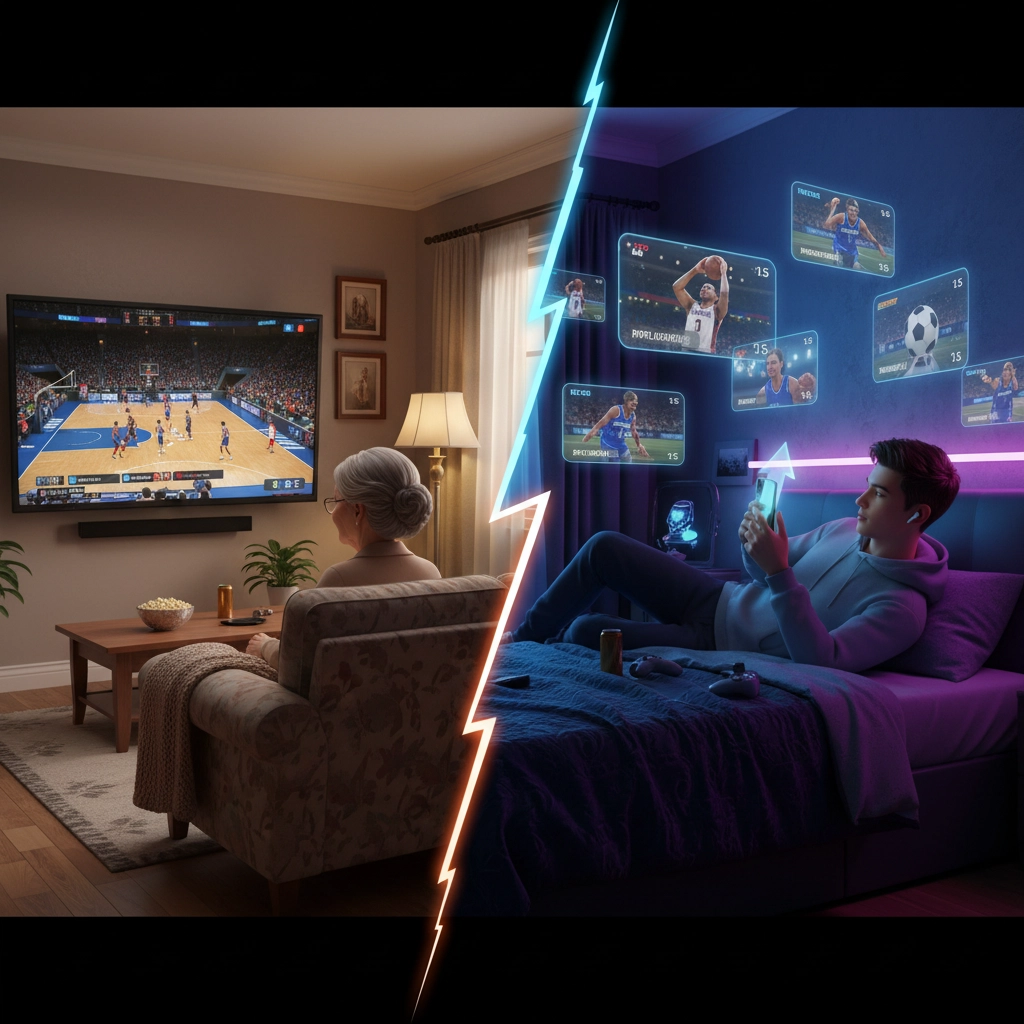The traditional sports broadcasting model faces significant disruption as viewing preferences shift dramatically across generational lines. Data indicates a fundamental change in how younger audiences consume sports content, with implications extending throughout the sports media industry.
The Statistical Reality of Changing Viewership
Current research demonstrates substantial differences in sports consumption patterns between age groups. Only 31% of sports fans aged 18-24 watch live full-length matches, compared to 75% of fans aged 55 and older. This disparity represents a 44 percentage point gap that continues to widen.
Among Gen Z viewers, 58% will watch sports live from start to finish, while 23% prefer highlight packages over complete game coverage. An additional 17% opt to view games through delayed viewing options rather than live broadcasts. These statistics indicate that traditional live viewership represents less than 60% of the youngest demographic.

The shift extends beyond viewing preferences to content source selection. Approximately 74% of young adults obtain sports content primarily through social media platforms rather than traditional broadcasting channels. YouTube serves as a primary sports content source for 49% of Gen Z users on a weekly basis.
Platform Migration and Consumption Patterns
Social media platforms have become the primary sports content delivery mechanism for younger demographics. The migration represents both a change in platform preference and consumption behavior modification.
Gen Z sports fans demonstrate 21% higher likelihood to engage with mobile gaming while watching sports content. Additionally, they show 20% greater tendency to use social media simultaneously during sports viewing sessions. This multi-platform engagement pattern differs significantly from traditional single-screen consumption models.
Audio content consumption has increased among younger sports fans, with average weekly engagement reaching 6 hours and 10 minutes. This format allows sports content consumption during activities where video viewing is impractical, such as commuting or exercise.
Content Format Preferences
Short-form content preference among Gen Z extends beyond convenience factors. The demographic demonstrates strong affinity for 15-second to 60-second highlight formats that capture key moments without requiring extended time commitments.
Research indicates a nearly 10% increase in time spent watching sports highlights among young audiences over recent measurement periods. This trend coincides with decreased engagement with full-length broadcast content.

Narrative-driven content formats have gained particular traction. Documentary-style sports content, exemplified by productions like Netflix's "Drive to Survive," has successfully attracted younger viewers through storytelling approaches that extend beyond game coverage to include athlete personalities and behind-the-scenes content.
Individual Athlete Focus Over Team Loyalty
Gen Z sports consumption patterns show stronger alignment with individual athletes rather than traditional team-based loyalty structures. This shift influences both content preferences and consumption timing.
Data indicates that 38% of Gen Z individuals do not maintain a favorite sports team. Among those who do claim team preferences, only 25% watch all or most of their team's games, compared to 37% across all adult demographics.
The focus on individual athletes correlates with social media following patterns, where young fans track specific players across platforms for both sports-related and personal content. This individual-centric approach allows for content consumption independent of scheduled team events.
Interactive and Supplementary Features
Younger sports fans demonstrate higher engagement levels when interactive features accompany content consumption. Live statistics, polling mechanisms, and sports betting integration show positive correlation with sustained attention among Gen Z viewers.

These interactive elements represent attempts to bridge the gap between passive viewing and active engagement that characterizes younger demographic preferences. The integration of supplementary features alongside traditional sports content creates hybrid consumption models.
Streaming platforms that incorporate interactive features report higher retention rates among viewers under 35, with 40% of this demographic utilizing sports-specific direct-to-consumer streaming applications regularly.
Industry Adaptation Requirements
Sports organizations and broadcasting entities face pressure to modify content delivery strategies to maintain relevance with younger demographics. Traditional broadcasting models require supplementation with short-form content production and multi-platform distribution strategies.
Content creators must develop capacity for rapid highlight generation and social media optimization. The production pipeline for sports content now includes immediate post-game processing for social media distribution alongside traditional broadcast preparation.
Revenue models require adjustment to account for audience fragmentation across platforms. Advertising strategies must adapt to shorter attention spans and multi-platform consumption patterns characteristic of Gen Z engagement.
Long-Term Implications for Sports Broadcasting
The viewing pattern changes among Gen Z suggest structural modifications will be necessary for sports media sustainability. Under-18 demographics now spend approximately 25% less time watching televised NFL games compared to measurements from eight years prior.

This trend trajectory indicates that traditional broadcasting models may become increasingly unsustainable as older demographics age out and younger demographics maintain alternative consumption preferences. Sports organizations must develop content strategies that accommodate both traditional and emerging consumption patterns.
The shift does not represent complete abandonment of sports interest among younger demographics. Instead, it indicates preference changes in content format, timing, and platform selection. Sports organizations that successfully adapt to these preferences maintain opportunities to engage younger audiences effectively.
Implementation Strategies for Sports Brands
Organizations seeking to engage Gen Z audiences should prioritize multi-format content production. This includes development of highlight packages, behind-the-scenes content, and athlete-focused narratives alongside traditional game coverage.
Social media platform optimization requires dedicated resources for content adaptation across different platform specifications. Content must be formatted appropriately for TikTok, Instagram Reels, YouTube Shorts, and other short-form video platforms.
Interactive feature integration should be considered for both live and recorded content distribution. Polling, statistics, and supplementary information can increase engagement levels among younger viewers who expect multi-dimensional content experiences.
The transformation of sports broadcasting reflects broader changes in media consumption patterns. Organizations that recognize and adapt to these shifts position themselves for continued audience engagement across generational demographics. Those that maintain exclusively traditional approaches risk diminishing relevance with emerging audience segments that will define future sports media consumption.
